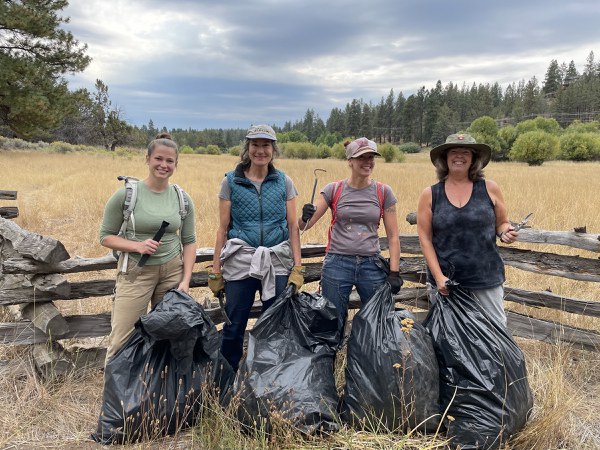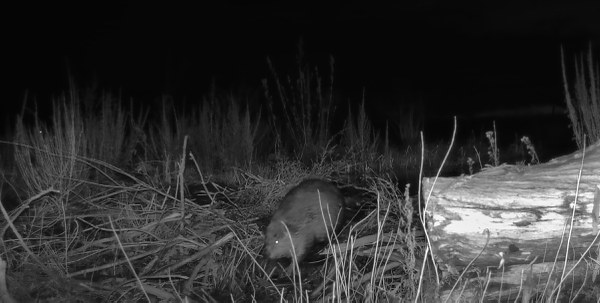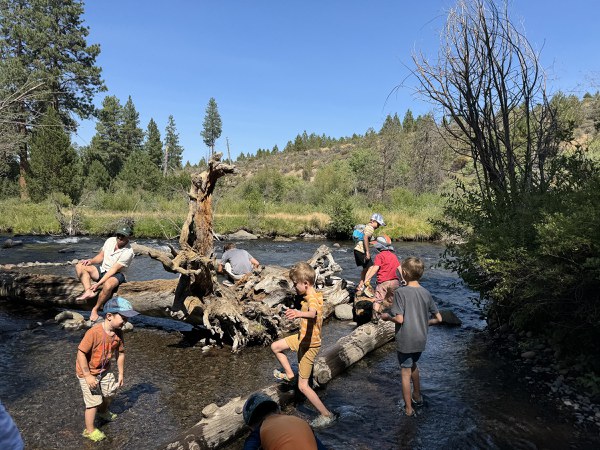This was an incredible year for conservation in Central Oregon!! We know this work is only accomplished in community, and we could not be more grateful for the support of ours! Thank you so much for the many ways you helped protect and restore the lands and waters we all love!
Here are 24 ways you helped conserve and care for Central Oregon’s lands and waters in 2024:
- Juniper Thinning
This year we thinned 100 acres of juniper trees at Priday Ranch and 203 acres at Rimrock Ranch. Thinning mimics historical wildfire patterns and preserves old growth trees. This supports a balance of different species that native wildlife need to thrive. We also did pile burning at Priday Ranch and Aspen Hollow Preserve as part of forest restoration to reduce wildfire danger at our Preserves. - Mussel Rescue
We collected more than 1,800 freshwater mussels from the Crooked River and Ochoco Creek and relocated them during phase two of our Ochoco Preserve Project. Mussels play an important role in water health by removing impurities, and they are part of the waterway’s habitat and food web. - Butterflies Abound
Butterflies’ short lifecycles mean they react quickly to changes in the environment, and seeing them tells us about the health of the land. This year our conservation and restoration work was rewarded by many exciting butterfly sightings! Monarch butterfly counts were up during their Pacific Northwest spring migration, and at the Metolius Preserve, we saw two new species of butterflies: the bramble hairstreak and the arrowhead blue. - Native Milkweed
To keep the Western monarch butterfly population healthy, we need to have enough milkweed in Central Oregon for caterpillars to survive. This year we gave away more than 19,000 showy milkweed seeds, helping create monarch habitat throughout the area! - More Than 75,000 Native Plants
This year, with the help of volunteers, work crews, and restoration partners, we planted more than 75,000 native plants on our Preserves! Native plants help conserve water, provide habitat for local wildlife, and reduce wildfire risk. - Weed Warriors
This summer, our Weed Warriors were in the news to spotlight their important work! We managed weeds on 18,000 acres of conserved lands, with volunteers putting in a whopping 1,400 hours to pull non-native plants! Photo: Land Trust.
Photo: Land Trust. - Fence Pulling
We removed approximately three miles of barbed wire fencing from Priday Ranch near Madras. Barbed wire is hazardous to migrating animals, so teams also modified fences at Paulina Creek Preserve to make passage safer. - Phase Two Restoration at Ochoco Preserve
The Land Trust completed Phase Two of the Ochoco Preserve Project, adding up to 130 restored acres! Phase two created new main channels and side channels to Ochoco Creek and part of the Crooked River. We added fish and wildlife habitat, constructed an acclimation pond, and established places for community connection. This was a major project that we couldn’t do without the support of our community! - Willow Springs Preserve Restoration
The second phase of the Willow Springs Preserve stream restoration was completed this year! The Land Trust’s restoration partner, the Upper Deschutes Watershed Council, continued work on part of Whychus Creek to create a healthy, biologically diverse creek. - Wildlife Crossings
The Land Trust teamed up with a coalition of local organizations, agencies, and the Confederated Tribes of Warm Springs to begin building wildlife crossings on Highway 20 in Central Oregon. The Bend to Suttle Lake Wildlife Passage Initiative will let migrating animals cross safely and reduce danger for people on busy highways. - Busy Beavers
We saw beaver activity in the restored part of Whychus Creek at Rimrock Ranch! Less than a year after the restoration of 1.5 miles of Whychus Creek and the surrounding valley floor, beavers built a dam on the creek. Beavers moving in is an important part of the continued evolution of Whychus Creek. Photo: Land Trust.
Photo: Land Trust. - Fish Reintroduction
We continued our partnership to reintroduce native fish in the upper Deschutes River region. At Camp Polk Meadow Preserve, 25,000 Chinook smolt (year old fish) acclimated before their journey downriver. At Ochoco Preserve, 5,000 Chinook and 5,000 steelhead used our new acclimation pond before heading to the Pacific Ocean. More than 250 steelhead salmon returned to the upper Deschutes River area this fall. This effort will support the long-term health of our wild fisheries. - Golden Eagles
Golden eagles nested at Aspen Hollow Preserve for the 15th consecutive year! Frank Isaacs, former Oregon Golden Eagle Nest Survey Manager, says this is the most successful nesting pair in Oregon in the past decade. Closing the Preserve during nesting season allows the large raptors to nest without human disturbance. - Nearly 3,000 Volunteer Hours
Volunteers gave close to 3,000 hours (and counting!) to the Land Trust this year! Our 2024 Outstanding Volunteers are Rick Dingus, Dick Malone, and Kathy Malone. We also honored new members of the Cottonwood Circle, who have volunteered with the Land Trust for ten years or more: Stella Dean, Clyde Dildine, Colleen Egertson, Kolby Kirk, Kathy Malone, David Margiott, Rod Moorehead, and Al St. John. We’re grateful to those in our community who so generously give of themselves in support of our work! - Elk Research
This spring, the Deschutes Land Trust assisted the Oregon Department of Fish and Wildlife (ODFW) with an elk research project. ODFW put GPS collars on two female elk this spring at Paulina Creek Preserve. These collars help track migration and habitat use of female Rocky Mountain elk in the Central Oregon Cascades. This study will help ODFW identify key migration routes and seasonal habitats. - Prescribed Burn Training
Two Land Trust staff members participated in this year’s Central Oregon Prescribed Fire Training Exchange (COTREX). Stewardship associates Peter Cooper and Gabriel Juarez learned about the local ecology of fire-adapted forests in Central Oregon and participated in prescribed burns—from scouting and preparation to ignitions, mop-up, and patrol. Peter and Gabriel also received their National Wildlife Coordinating Group Firefighter 2 certification (known as a red card). - Staging for the Darlene 3 Fire
At the end of June, the first big wildfire of the season hit close to home for many, including the Land Trust. The Darlene 3 Fire was very near Paulina Creek Preserve. Throughout the fire, the Land Trust attended daily briefings and worked with the incident management team to support firefighting efforts. We offered Paulina Creek Preserve as a temporary base camp, and the Preserve served as a helicopter landing pad for reconnaissance flights. - Nearly 100 Walks + Hikes
This year our community participated in nearly 100 guided tours of our conserved lands. Visitors learned about geology, birds, pollinators and the plants they love, nature journaling, star gazing, and forest bathing! Thanks for learning about and loving nature with us! Photo: Land Trust.
Photo: Land Trust. - Nature Kids
This year we launched Nature Kids, our new program of guided nature walks for families with kids ages 5-10! We also continued to offer other kid-focused Walks + Hikes from early spring to late fall. Giving kids opportunities for outdoor exploration is an important part of preserving our waters and lands for future generations! - First Steps Towards Restoration at Paulina Creek Preserve
We will start forest restoration efforts at Paulina Creek Preserve this winter. Our goal is to thin lodgepole pine to favor ponderosa pine in dense forest near the Preserve’s southern border. This will also reduce the risk of wildfire for neighboring homes. - Monitoring Conserved Lands
Property monitoring is one of the most important procedures used by Land Trust staff. We monitor our conserved lands every year to make management decisions, track changes over time, and understand how lands are being used by the public. - Nature Nights
This year, we hosted presentations from experts on bees, soil, and a moving presentation introducing the history and future of the Klamath Tribes. Nearly 900 of you joined us to learn about these topics. We can’t wait to share what we have lined up for you next! - Partnership with the Klamath Tribes
We are also happy to build our relationship with the Klamath Tribes, the original stewards of the land where Paulina Creek Preserve is situated. The Land Trust shared close to 400 showy and narrowleaf milkweed plants and other pollinator plants with the Klamath tribal community in collaboration around our shared conservation goals. - Updates at Indian Ford Meadow Preserve
We updated the viewing platform at Indian Ford Meadow Preserve. The platform includes a new base with stone pavers, updated interpretive signs, and a viewing scope—dedicated to the memory of Cal Allen—to see the mountains up close.
We are humbled and inspired every year by the incredible work made possible by our community of supporters! Thank you so much for caring for the lands of Central Oregon—today and for the future!
Learn more:
- Join us and become a Land Trust supporter—donate today!
- Find out more about our current projects


